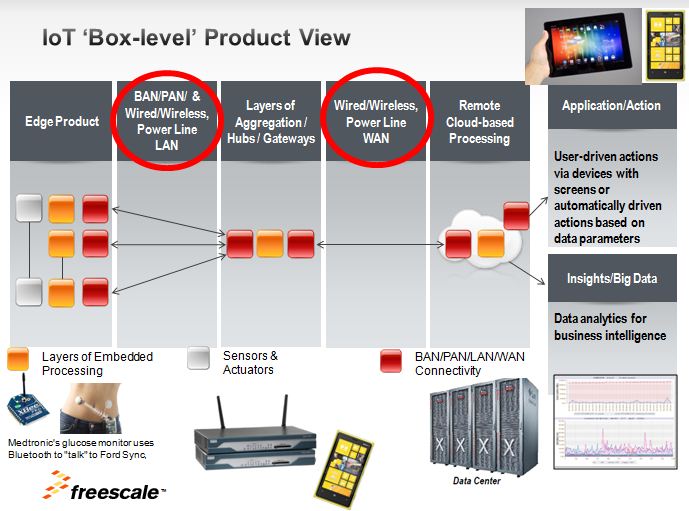IoT gateways are of interest to wireless service providers who are looking to the “Internet of Things” for new revenue.
What is an IoT gateway?
An IoT gateway is a device that enables machine-to-machine communication by connecting appliances in the home, workplace or smart city to cellular or Wi-Fi networks. IoT gateways are built on chipsets that include low-power connectivity (typically ZigBee or BlueTooth) and data processing capabilities.
An IoT gateway can make M2M the fourth leg of a “quad play,” according to Nick Sargologos, senior marketing manager for Freescale’s digital networking division. Sargologos said that service providers who are already offering voice, Internet and home video can leverage an IoT gateway to add smart home applications to their offerings. Freescale has just introduced a new IoT reference design that the company says should allow service providers to unify multiple IoT solutions in a single box. Freescale is one of several leading chipmakers focusing on the Internet of Things; Texas Instruments and Intel also make IoT gateways.
Use cases
Smart energy solutions are an important use case for IoT gateways. Zigbee chipsets are used in most U.S. smart energy meters, according to Texas Instruments. IoT gateways connect these systems to Wi-Fi routers and Ethernet, making it easier to monitor or control smart meters using a mobile device.
In addition, IoT gateways can be used to monitor and track valuable assets within an enterprise or in transit. These same assets are often candidates for wireless sensor technology, creating an opportunity for the IoT gateway to collect data from the sensor. Chipmakers are working closely with companies like IBM and Oracle to enable data collection and analysis through IoT gateways.
“There’s a lot of interest in tracking assets, very high value assets, pharmaceutical equipment, medical equipment, or sensitive assets,” said Caroline Chan, wireless segment manager at Intel. “So all of that actually makes very interesting the combination of Wi-Fi and cellular together.”
“Small cells are convenient, meaning that you are much, much closer to the user and to the asset,” said Chan. “But there is also an element where you need to combine that with the macro because eventually that does leave the enterprise and go somewhere else. So I think we’re just at the very beginning. The potential is very bright.”
Watch the full RCR interview with Caroline Chan:

